This was published 2 years ago
Opinion
Emerging humanitarian crisis in Ukraine a test for Australia
Abul Rizvi
Former deputy secretary of the Department of ImmigrationThe latest figures from the UNHCR report that around 50,000 refugees have fled Ukraine and another 100,000 are internally displaced. Various estimates suggest a refugee outflow ranging from 1 million to 4 million over the next few weeks.
Apart from some notable exceptions, Australia has a long tradition of being responsive and generous in humanitarian crises. Among world leaders at the time, it was Australian prime minister Ben Chifley who broke the re-settlement log-jam by accepting 100,000 displaced persons after World War II, predominantly people of the Jewish faith, who other nations were initially unwilling to accept.

A refugee who fled the conflict from neighbouring Ukraine sits next to her son Maxim, 5 months old, in the hall of a hotel offering shelter in Siret, Romania.Credit: AP
While that decision was not without its critics within Australia, Chifley’s leadership firmly established Australia’s credentials as a humanitarian nation. Under Malcolm Fraser, Australia took a leadership role after the Vietnam War. Bob Hawke’s response to the plight of Chinese students after the Tiananmen Square massacre was, at least initially, pure passion, and eventually Paul Keating gave the students permanent residence.
However, in recent decades we have become more miserly. John Howard’s response to the Kosovar crisis of the late 1990s was positive, but only following significant international and domestic pressure. His subsequent treatment of asylum seeker boats has given Australia a very different reputation that is ongoing. Tony Abbott and Malcolm Turnbull eventually accepted 20,000 refugees fleeing the Syrian conflict of 2015.
More recently, Scott Morrison had to be dragged to developing a limited response to the humanitarian crisis in Afghanistan even though Australia had a long-standing role in the Afghanistan War.
Will he do better with the rapidly emerging humanitarian crisis in Ukraine? The initial response to most such crises is to allow temporary entrants in Australia from the relevant area to remain in Australia at least until the situation becomes clearer.

A man carries his one-month-old as he arrives in Poland after crossing the border in Kroscienko on Sunday.Credit: Getty Images
Immigration Minister Alex Hawke has indicated he will do the same for Ukrainian citizens temporarily in Australia, providing a six-month extension of stay for all Ukrainian temporary visa holders whose visas expire before June 30, 2022.
By the end of January, there were 1430 temporary entrants in Australia from Ukraine, 602 of whom were crew or others transiting Australia. Another 254 were on bridging visas; 88 students; 191 visitors; 39 temporary graduates; 187 on skilled temporary visas and another 67 on other temporary employment visas.
Another option is to speed up the processing of partner visa applications from Ukrainian nationals who are in a relationship with an Australian. The slow processing of these visa applications until very recently has been shameful (and most likely unlawful). The government has announced it will prioritise all visa applications from Ukrainian nationals although what this means remains unclear given the gridlock in Australia’s visa system.
Beyond that, Australia’s humanitarian response will depend on how the situation develops. One option is to offer temporary safe haven visas such as were used for Kosovars fleeing the Kosovo-Serbia conflict in the late 1990s.
Australia offered 4000 Kosovars temporary safe haven. As the places were designed to be temporary and all the Kosovars were expected to be returned in three months, the places were in addition to the standard Humanitarian Program.
The temporary nature of the visas – the Kosovars were legally not permitted to apply for permanent residence – together with the major role played by the UNHCR and NATO military cover, enabled the rapid uplift of the Kosovar refugees. The standard permanent residence visa processing requirements, including health and character, were not used.
The government also required that under law “there be no presumption of entitlement to financial support under the scheme other than the provision by the Commonwealth of food, lodging, basic health care and the basic necessities of life”.
All the Kosovars were housed on eight disused defence force bases, many of which have now been either sold or are being used for other purposes.
A Kosovar style response would require the government to provide appropriate accommodation for Ukrainian refugees, possibly in the quarantine facilities now being developed in various parts of Australia, unless relatives in Australia or community sponsorship can assist.
If the crisis is likely to be prolonged, the temporary safe haven approach would not be suitable. A key issue will be whether there is a need to assist displaced persons within Ukraine, noting co-operation of the Ukrainian government would be essential, or to assist with the refugee outflow into Poland and Romania.
Both nations have land borders with Ukraine and are part of NATO. But they are on the west of Ukraine whereas much of the fighting is also on the Ukraine/Russia border on the east. Assisting displaced persons in that part of Ukraine would be significantly more difficult.
Australia is likely to support the UNHCR, which would lead any international humanitarian effort. After significantly reducing the size of the current Humanitarian Program and a multitude of existing demands on it, the government would need to enlarge the program if it is to provide any meaningful long-term assistance.
Get a note directly from our foreign correspondents on what’s making headlines around the world. Sign up for the weekly What in the World newsletter here.